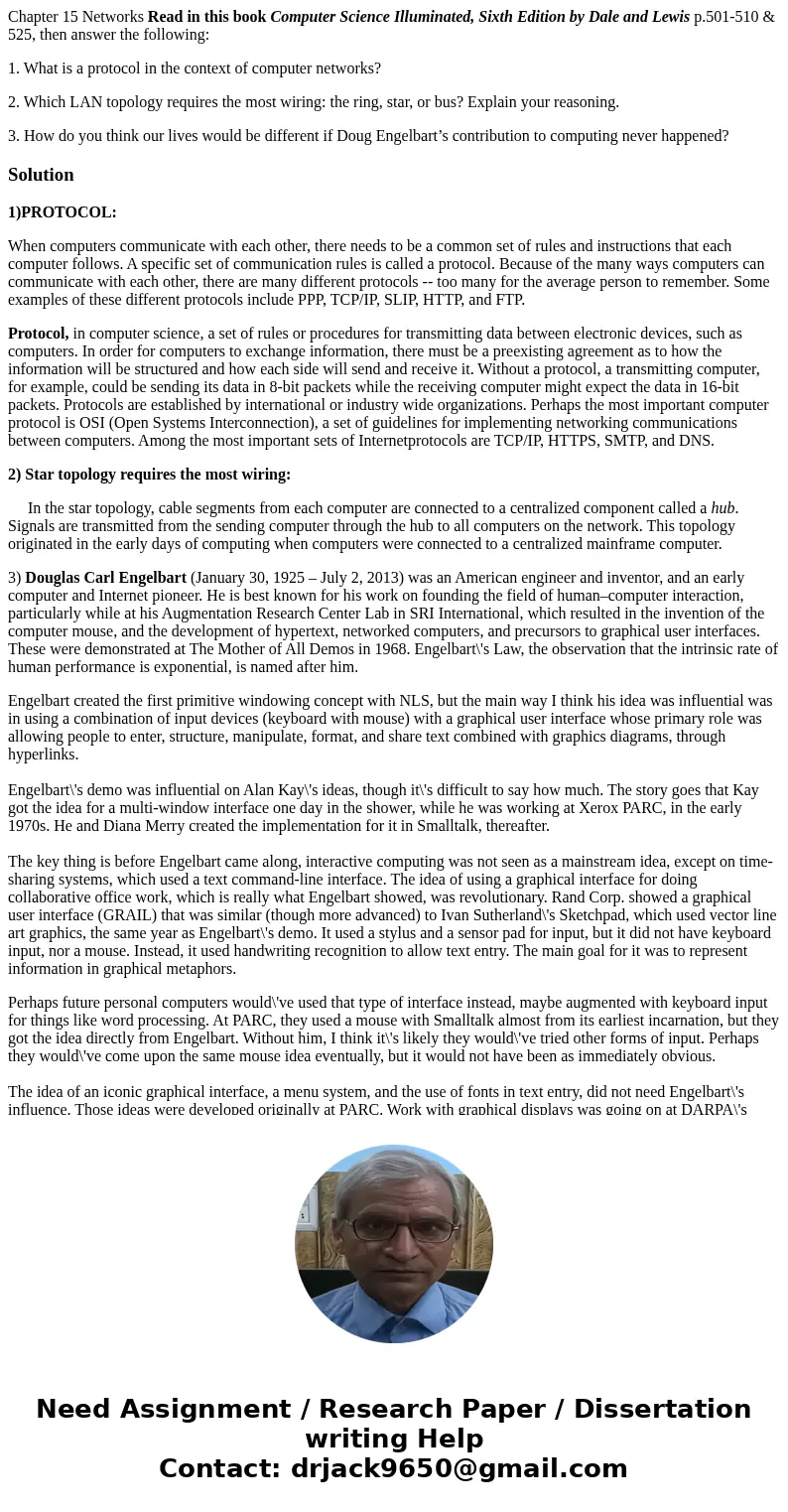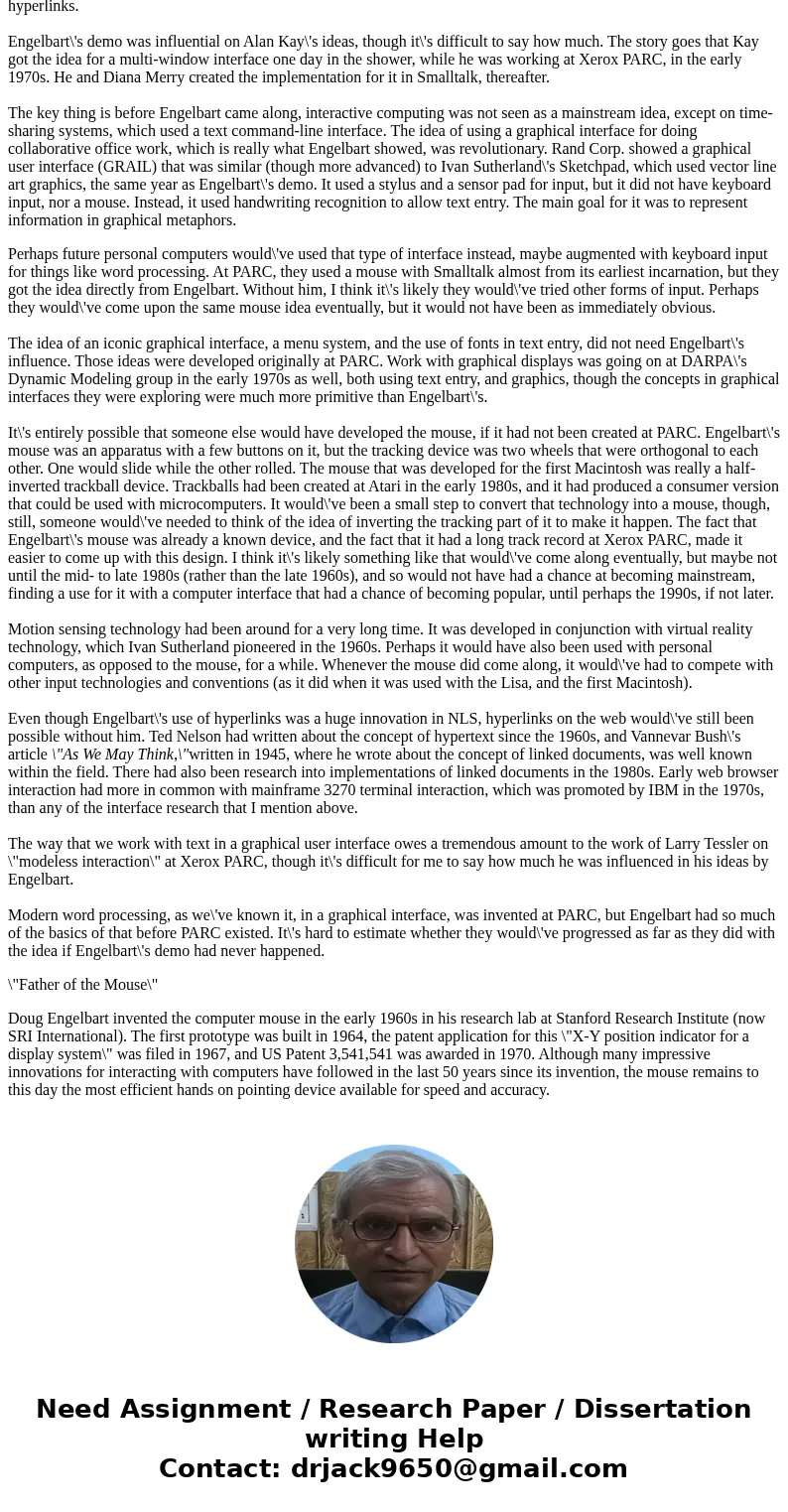Chapter 15 Networks Read in this book Computer Science Illum
Chapter 15 Networks Read in this book Computer Science Illuminated, Sixth Edition by Dale and Lewis p.501-510 & 525, then answer the following:
1. What is a protocol in the context of computer networks?
2. Which LAN topology requires the most wiring: the ring, star, or bus? Explain your reasoning.
3. How do you think our lives would be different if Doug Engelbart’s contribution to computing never happened?
Solution
1)PROTOCOL:
When computers communicate with each other, there needs to be a common set of rules and instructions that each computer follows. A specific set of communication rules is called a protocol. Because of the many ways computers can communicate with each other, there are many different protocols -- too many for the average person to remember. Some examples of these different protocols include PPP, TCP/IP, SLIP, HTTP, and FTP.
Protocol, in computer science, a set of rules or procedures for transmitting data between electronic devices, such as computers. In order for computers to exchange information, there must be a preexisting agreement as to how the information will be structured and how each side will send and receive it. Without a protocol, a transmitting computer, for example, could be sending its data in 8-bit packets while the receiving computer might expect the data in 16-bit packets. Protocols are established by international or industry wide organizations. Perhaps the most important computer protocol is OSI (Open Systems Interconnection), a set of guidelines for implementing networking communications between computers. Among the most important sets of Internetprotocols are TCP/IP, HTTPS, SMTP, and DNS.
2) Star topology requires the most wiring:
In the star topology, cable segments from each computer are connected to a centralized component called a hub. Signals are transmitted from the sending computer through the hub to all computers on the network. This topology originated in the early days of computing when computers were connected to a centralized mainframe computer.
3) Douglas Carl Engelbart (January 30, 1925 – July 2, 2013) was an American engineer and inventor, and an early computer and Internet pioneer. He is best known for his work on founding the field of human–computer interaction, particularly while at his Augmentation Research Center Lab in SRI International, which resulted in the invention of the computer mouse, and the development of hypertext, networked computers, and precursors to graphical user interfaces. These were demonstrated at The Mother of All Demos in 1968. Engelbart\'s Law, the observation that the intrinsic rate of human performance is exponential, is named after him.
Engelbart created the first primitive windowing concept with NLS, but the main way I think his idea was influential was in using a combination of input devices (keyboard with mouse) with a graphical user interface whose primary role was allowing people to enter, structure, manipulate, format, and share text combined with graphics diagrams, through hyperlinks.
Engelbart\'s demo was influential on Alan Kay\'s ideas, though it\'s difficult to say how much. The story goes that Kay got the idea for a multi-window interface one day in the shower, while he was working at Xerox PARC, in the early 1970s. He and Diana Merry created the implementation for it in Smalltalk, thereafter.
The key thing is before Engelbart came along, interactive computing was not seen as a mainstream idea, except on time-sharing systems, which used a text command-line interface. The idea of using a graphical interface for doing collaborative office work, which is really what Engelbart showed, was revolutionary. Rand Corp. showed a graphical user interface (GRAIL) that was similar (though more advanced) to Ivan Sutherland\'s Sketchpad, which used vector line art graphics, the same year as Engelbart\'s demo. It used a stylus and a sensor pad for input, but it did not have keyboard input, nor a mouse. Instead, it used handwriting recognition to allow text entry. The main goal for it was to represent information in graphical metaphors.
Perhaps future personal computers would\'ve used that type of interface instead, maybe augmented with keyboard input for things like word processing. At PARC, they used a mouse with Smalltalk almost from its earliest incarnation, but they got the idea directly from Engelbart. Without him, I think it\'s likely they would\'ve tried other forms of input. Perhaps they would\'ve come upon the same mouse idea eventually, but it would not have been as immediately obvious.
The idea of an iconic graphical interface, a menu system, and the use of fonts in text entry, did not need Engelbart\'s influence. Those ideas were developed originally at PARC. Work with graphical displays was going on at DARPA\'s Dynamic Modeling group in the early 1970s as well, both using text entry, and graphics, though the concepts in graphical interfaces they were exploring were much more primitive than Engelbart\'s.
It\'s entirely possible that someone else would have developed the mouse, if it had not been created at PARC. Engelbart\'s mouse was an apparatus with a few buttons on it, but the tracking device was two wheels that were orthogonal to each other. One would slide while the other rolled. The mouse that was developed for the first Macintosh was really a half-inverted trackball device. Trackballs had been created at Atari in the early 1980s, and it had produced a consumer version that could be used with microcomputers. It would\'ve been a small step to convert that technology into a mouse, though, still, someone would\'ve needed to think of the idea of inverting the tracking part of it to make it happen. The fact that Engelbart\'s mouse was already a known device, and the fact that it had a long track record at Xerox PARC, made it easier to come up with this design. I think it\'s likely something like that would\'ve come along eventually, but maybe not until the mid- to late 1980s (rather than the late 1960s), and so would not have had a chance at becoming mainstream, finding a use for it with a computer interface that had a chance of becoming popular, until perhaps the 1990s, if not later.
Motion sensing technology had been around for a very long time. It was developed in conjunction with virtual reality technology, which Ivan Sutherland pioneered in the 1960s. Perhaps it would have also been used with personal computers, as opposed to the mouse, for a while. Whenever the mouse did come along, it would\'ve had to compete with other input technologies and conventions (as it did when it was used with the Lisa, and the first Macintosh).
Even though Engelbart\'s use of hyperlinks was a huge innovation in NLS, hyperlinks on the web would\'ve still been possible without him. Ted Nelson had written about the concept of hypertext since the 1960s, and Vannevar Bush\'s article \"As We May Think,\"written in 1945, where he wrote about the concept of linked documents, was well known within the field. There had also been research into implementations of linked documents in the 1980s. Early web browser interaction had more in common with mainframe 3270 terminal interaction, which was promoted by IBM in the 1970s, than any of the interface research that I mention above.
The way that we work with text in a graphical user interface owes a tremendous amount to the work of Larry Tessler on \"modeless interaction\" at Xerox PARC, though it\'s difficult for me to say how much he was influenced in his ideas by Engelbart.
Modern word processing, as we\'ve known it, in a graphical interface, was invented at PARC, but Engelbart had so much of the basics of that before PARC existed. It\'s hard to estimate whether they would\'ve progressed as far as they did with the idea if Engelbart\'s demo had never happened.
\"Father of the Mouse\"
Doug Engelbart invented the computer mouse in the early 1960s in his research lab at Stanford Research Institute (now SRI International). The first prototype was built in 1964, the patent application for this \"X-Y position indicator for a display system\" was filed in 1967, and US Patent 3,541,541 was awarded in 1970. Although many impressive innovations for interacting with computers have followed in the last 50 years since its invention, the mouse remains to this day the most efficient hands on pointing device available for speed and accuracy.


 Homework Sourse
Homework Sourse